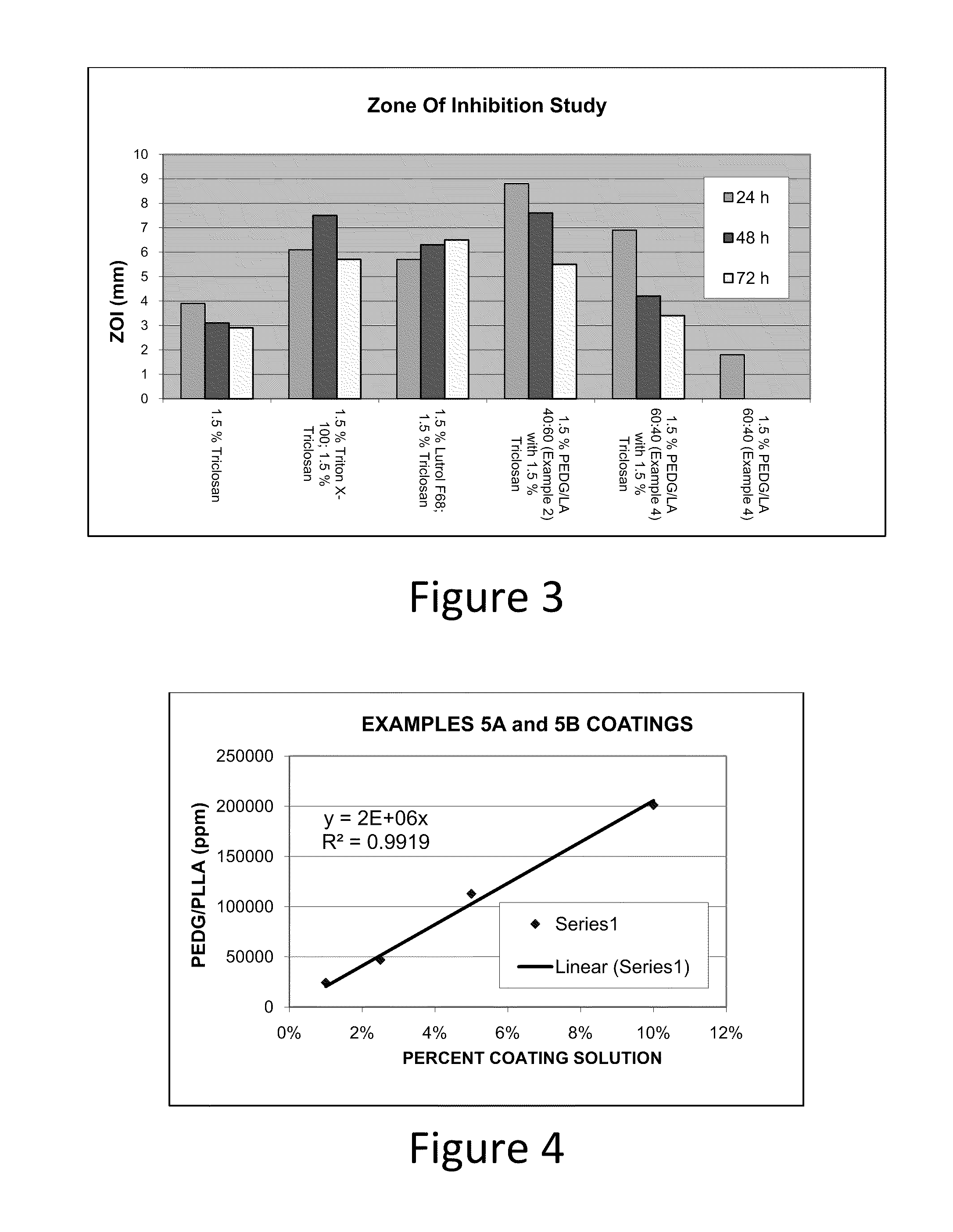Absorbable polyethylene diglycolate copolymers to reduce microbial adhesion to medical devices and implants
a technology of absorbable polyethylene and diglycolate, which is applied in the direction of prosthesis, peptide, surgical adhesive, etc., can solve the problems of affecting the adhesion of bacteria to medical devices and implants, the substance is easily displaced from a surface, and the peg is not absorbable in the human body, so as to reduce the attachment of bacteria
- Summary
- Abstract
- Description
- Claims
- Application Information
AI Technical Summary
Benefits of technology
Problems solved by technology
Method used
Image
Examples
example 1
Synthesis of Hydroxy Terminated Poly(ethylene diglycolate) (PEDG)
[0040]A twin-agitated reactor with intermeshing HELICONE patterned blades (Atlantic 10CV reactor) was employed. After charging the reactor with 10.0 kg of diglycolic acid, 13.9 kg of ethylene glycol (EG) and 1.86 grams of dibutyltin oxide catalyst, the pressure was reduced to below 1 Torr and the vacuum preserved overnight. The next day the vacuum was released with dry nitrogen (argon can be substituted) and the heating of mixture started. When the reactor temperature reached 150° C., an agitator speed was set to 30 RPM. Soon first distillate appeared containing mostly water, an esterification by-product. The reaction was continued at 165° C. for a couple of more hours until approximately all water was distilled and / or first traces of EG appeared in the distillate. After the first nitrogen / argon stage was completed, pressure was lowered gradually to full vacuum in steps while the temperature of the batch was maintained...
example 2
The Copolymerization of Hydroxy Terminated Poly(ethylene diglycolate) with a L(−)-lactide, (PLLA): Copolymer Composition (PEDG / PLLA 40 / 60 Wt. %)
[0041]A portion of the Poly(ethylene diglycolate) made in Example 1 (36.0 g) with IV=0.37 dL / g was added into an oven dried 250 milliliter round bottom flask. In the nitrogen glove box, the L(−)-lactide (54.0 g) and catalyst, Stannous Octoate (0.019 ml) were charged. A mechanical stirrer, nitrogen adapter and stirrer bearing were added to the 250 ml flask's neck opening. The vessel was pulled under a vacuum of less than 500 mTorr at room temperature and held overnight. The polymer was reacted using a stepped temperature profile. The next day the flask was released to nitrogen and placed in the oil bath. The bath temperature was set to 190° C. without agitation. Once the temperature reached approximately 110° C. the mechanical stirrer was set at 4 RPM. When the melt appeared homogenous and clear at about 170° C., the agitation was reduced to ...
example 3
The Copolymerization of Hydroxy Terminated Poly(ethylene diglycolate) with a L(−)-lactide, (PLLA): Copolymer Composition (PEDG / PLLA 50 / 50 Wt. %)
[0043]A portion of the poly(ethylene diglycolate) made in Example 1 (50.0 g) with IV=0.37 dL / g was added into an oven dried 250 milliliter round bottom flask. In the nitrogen glove box, the L(−)-lactide (50.0 g) and catalyst, Stannous Octoate (0.018 ml) were charged. Polymerization procedure was identical to that described in Example 2.
[0044]The final polymer conversion was calculated to be 97.4%. At room temperature the copolymer is a light yellowish fully amorphous solid, with the softening point, as determined by Fisher-Johns method, of 83° C. The weight average molecular weight, Mw is 24,000 g / mol, and IV 0.53 dL / g.
PUM
| Property | Measurement | Unit |
|---|---|---|
| molar ratio | aaaaa | aaaaa |
| molar ratio | aaaaa | aaaaa |
| temperature | aaaaa | aaaaa |
Abstract
Description
Claims
Application Information
 Login to View More
Login to View More - R&D
- Intellectual Property
- Life Sciences
- Materials
- Tech Scout
- Unparalleled Data Quality
- Higher Quality Content
- 60% Fewer Hallucinations
Browse by: Latest US Patents, China's latest patents, Technical Efficacy Thesaurus, Application Domain, Technology Topic, Popular Technical Reports.
© 2025 PatSnap. All rights reserved.Legal|Privacy policy|Modern Slavery Act Transparency Statement|Sitemap|About US| Contact US: help@patsnap.com


